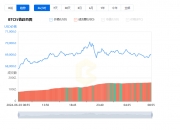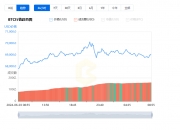币圈是一个专注于数字货币交易的金融市场,其中主流的衍生产品包括合约与期货。这两种衍生品让投资者无需持有实际资产,即可通过买涨卖跌合约或期权,捕获价格波动带来的利润。其优势在于可依据行情走向选择交易方向,无论是看涨做多,还是看跌做空,币价上涨时可通过做多获利,下跌时则可通过做空盈利。然而,合约与期货也蕴含着高风险,一旦价格走势与预期相悖,投资者可能会遭遇爆仓或亏损的风险。
Currency circles are financial markets that focus on digital currency transactions, with mainstream derivatives including contracts and futures. These two derivatives allow investors to capture profits from price fluctuations without having to hold real assets.
揭示交易市场的底层逻辑——人性的弱点在交易市场上,人性的诸多弱点往往暴露无遗,并被进一步放大。贪婪、恐惧、随波逐流及坚持错误这四大常见弱点,常常导致投资者在币圈合约与期货这类高风险高回报市场中作出错误决策,如过度杠杆化、追涨杀跌、盲目从众以及固守错误等,进而造成亏损。
In the trading markets, human vulnerabilities are often exposed and further magnified. The four common weaknesses of greed, fear, drifting and insistence on mistakes often lead investors to make wrong decisions in high-risk, high-return markets such as currency-ring contracts and futures, such as overleveraging, upswing and falling, blinding from the crowd, and upholding mistakes, thereby causing losses.
运用市场情绪与预期制定交易策略1. 判断市场情绪周期:市场情绪大致可分为冰点、回暖、主升、高潮、退潮五个阶段,每个阶段对应不同的交易策略,如冰点阶段采取逢低买入等逆市操作,高潮阶段则适合卖出跟风等逢高卖出策略。
1. Determining the market mood cycle: Market moods can be broadly divided into ice points, warmth, main rises, orgasms and retreats, each of which corresponds to different trading strategies, such as low-buying counter-market operations at the ice point and high-sale strategies at the peak.
2. 分析市场预期偏差:市场预期源于多方面因素的分析或猜测,当实际结果与预期一致、优于或劣于预期时,市场情绪随之起伏。因此,密切关注市场预期与实际结果的偏差有助于把握市场情绪变化趋势。
Analysis of market-expected deviations: Market expectations derive from analysis or speculation based on multiple factors, with market moods ebbing when actual results are consistent with, superior to or inferior to expectations. Therefore, closer attention to market-expected and actual-result deviations helps to capture trends in market-based mood change.
3. 调整仓位与杠杆:市场情绪高涨时,可适度增加仓位和杠杆以放大收益;反之,在市场情绪低迷时,则应减小仓位和杠杆以降低风险。但切忌过度贪婪或恐惧,始终保持理性与冷静,并随着市场预期变化及时调整交易策略。
3. Re-positioning and leveraging: Market sentiment increases with modest increases in position and leverage to magnify gains; conversely, when market moods fall, they reduce risk. But beware of excessive greed or fear, remain rational and calm, and adjust trading strategies in a timely manner as the market is expected to change.
4. 寻找套利机会:市场情绪与预期与基本面、技术面存在较大偏离时,常孕育出套利机遇。例如,在市场过热或过冷时,可以运用价值投资理念发掘被低估或高估的投资标的;在非理性泡沫或恐慌时期,采用反向交易策略,实施与大众相反的操作;而在市场价格失衡时,则利用套利交易法则,利用价格差异或相关性创造稳定收益。
4. Finding arbitrage opportunities: arbitrage opportunities often arise when market moods and expectations deviate significantly from fundamentals and technology. For example, when markets are overheated or cold, the concept of value investment can be used to extract undervalued or overvalued investment targets; in times of irrational bubbles or panic, counter-trading strategies are used to carry out operations contrary to those of the general public; in times of market price imbalances, arbitrage is used to create stable returns using price differences or correlations.
5. 把握市场节奏:市场情绪与预期具有传染性,会在不同板块、个股、时间段间产生联动效应。因此,投资者在币圈合约与期货交易中需敏锐捕捉市场节奏,紧跟热点与风口,同时防范风险和陷阱。
5. Managing market rhythms: Market moods and expectations are contagious and have an interconnectivity effect across sections, shares and periods. Therefore, investors need to be keen to capture market rhythms in currency-ring contracts and futures transactions, keeping close to hot spots and winds, while at the same time protecting against risks and pitfalls.
结语:以上即是本文探讨的币圈合约与期货交易策略进阶技巧——如何运用市场情绪与预期制定多空双向交易策略。期待本文能为您的交易实践提供有益指导!
Conclusions: This is the next step in the strategy of currency-circle contracts and futures transactions discussed here - how to use market sentiment and expectations to develop multi-empty two-way trading strategies. It is expected that this paper will provide useful guidance on your trading practices.
注册有任何问题请添加 微信:MVIP619 拉你进入群

打开微信扫一扫
添加客服
进入交流群



















发表评论